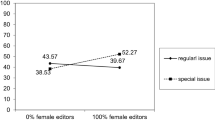Abstract
In psychological research there is huge literature on differences between the sexes. Typically it used to be thought that women were more verbally and men more spatially oriented. These differences now seem to be waning. In this article we present three studies on sex differences in the use of tables and graphs in academic articles. These studies are based on data mining from approximately 2,000 articles published in over 200 peer-reviewed journals in the sciences and social sciences. In Study 1 we found that, in the sciences, men used 26 % more graphs and figures than women, but that there were no significant differences between them in their use of tables. In Study 2 we found no significant differences between men and women in their use of graphs and figures or tables in social science articles. In Study 3 we found no significant differences between men and women in their use of what we termed ‘data’ and ‘text’ tables in social science articles. It is possible that these findings indicate that academic writing is now becoming a genre that is equally undertaken by men and women.




Similar content being viewed by others
Notes
Holpuch (2013) reports a recent news item stressing the sexist mindset of some people about women in Science: “to the apparent shock of some Facebook users, girls can be quite good at science.”
References
van Arensbergen, P., van der Weijden, I. & van den Besselaar, P. (2012). Gender differences in scientific productivity: A persisting phenomenon? Scientometrics, 93(3), 857–868. doi:10.1007/s11192-012-0712-y.
Ashwin, P. (2012). How often are theories developed through empirical research into higher education? Studies in Higher Education, 37(8), 941–955. doi:10.1080/03075079.2011.557426.
Carter, L. F. (1947). An experiment on the design of tables and graphs used for presenting numerical data. Journal of Applied Psychology, 31(6), 640–650. doi:10.1037/h0054246.
Chambers, J. M., Cleveland, W.S., Kleiner, B. & Tukey, P. A. (1983). Graphical Methods for Data Analysis. Pacific Grove: Statistics/Probability, Wadsworth & Brooks/Cole.
Cleveland, W. S. (1994). The elements of graphing data (2nd ed.). New Jersey: Hobart Press.
Gelman, A.,, Pasarica, C., & Dodhia, R. (2002). Let’s practice what we preach: Turning tables into graphs. The American Statistician, 56(2), 121–130. doi:10.1198/000313002317572790.
Good, C., Rattan, A., & Dweck, C. S. (2012). Why do women opt out? Sense of belonging and womens representation in mathematics. Journal of Personality and Social Psychology, 102(4), 700–717.
Hanson, B., Sugden, A., & Alberts, B. (2011). Making data maximally available. Science, 331(6018),649. doi:10.1126/science.1203354.
Hartley, J. (2006). Plus ça change\(\ldots\) Gender preferences for academic disciplines. Higher Education Review, 38(2), 77–81.
Hartley, J. (2008). Academic writing and publishing: A practical handbook. Abingdon: Routledge.
Hegarty, P., & Walton, Z. (2012). The consequences of predicting scientific impact in psychology using journal impact factors. Perspectives on Psychological Science, 7(1), 72–78 doi:10.1177/1745691611429356.
Heim, A. W. (1970). Intelligence and Personality: Their Assessment and Relationship. Harmondsworth: Penguin Books Ltd, Harmondsworth.
Holpuch, A. (2013). Popular science blog is run by a woman—to the surprise of some on Facebook. The guardian. http://gu.com/p/3etf8/tw
Hyde, J. S., Lindberg, S. M., Linn, M. C., Ellis, A. B., & Williams, C. C. (2008). Diversity: Gender similarities characterize math performance. Science, 321(5888), 494–495. doi:10.1126/science.1160364.
Isiksal, M., & Cakiroghi, E. (2008). Gender differences regarding mathematics achievement: The case of Turkish middle school students. School Science and Mathematics, 108(3), 113–120, doi:10.1111/j.1949-8594.2008.tb17814.x.
Kretschmer, H., Kundra, R., Beaver, Dd., & Kretschmer, T. (2012a). Gender bias in journals of gender studies. Scientometrics, 93(1), 135–150 doi:10.1007/s11192-012-0661-5.
Kretschmer, H., Pudovkin, A., & Stegmann, J. (2012b). Research evaluation. Part II. Gender effects of evaluation: Are men more productive and more cited than women? Scientometrics, 93(1), 17–30. doi:10.1007/s11192-012-0658-0.
Maccoby, E. E., & Jacklin, C. N. (1974). The psychology of sex differences, vol 1: Text. Stanford: Stanford University Press.
Maeda, Y., & Yoon, S. Y. (2013). A meta-analysis on gender differences in mental rotation ability measured by the Purdue spatial visualization tests: Visualization of rotations (PSVT:R). Educational Psychology Review, 25(1), 69–94. doi:10.1007/s10648-012-9215-x.
McGill, R., Tukey, J. W., & Larsen, W. A. (1978). Variations of box plots. The American Statistician, 32(1), 12. doi: 10.2307/2683468.
Park, H. S. (2005). Gender difference in mathematical disposition of middle school students in Korea. In ICMI’05: Proceedings of the 3rd East Asia Regional Conference on Mathematics Education.
Peterson, S. S., & Parr, J. (2012). Gender and literacy issues and research: Placing the spotlight on writing. Journal of Writing Research 3(3), 151–161.
Robinson, J. P., & Lubienski, S. T. (2011). The development of gender achievement gaps in mathematics and reading during elementary and middle school: Examining direct cognitive assessments and teacher ratings. American Educational Research Journal, 48(2), 268–302. doi:10.3102/0002831210372249.
Schucan, Bird. K. (2011). Do women publish fewer journal articles than men? Sex differences in publication productivity in the social sciences. British Journal of Sociology of Education, 32(6), 921–937. doi:10.1080/01425692.2011.596387.
Smith, L. D., Best, L. A., Stubbs, D. A., Archibald, A. B., & Roberson-Nay, R. (2002). Constructing knowledge: The role of graphs and tables in hard and soft psychology. American Psychologist, 57(10), 749–761. doi:10.1037/0003-066X.57.10.749.
Speier, C. (2006). The influence of information presentation formats on complex task decision-making performance. International Journal of Human-Computer Studies, 64(11), 1115–1131 doi:10.1016/j.ijhcs.2006.06.007.
Strand, S., Deary, I. J., & Smith, P. (2006). Sex differences in cognitive abilities test scores: A UK national picture. British Journal of Educational Psychology, 76(3), 463–480 doi:10.1348/000709905X50906.
Tufte, E. R. (1983). The visual display of quantitative information. Cheshire: Graphics Press.
Wai, J., Putallaz, M., & Makel, M. C. (2012). Studying intellectual outliers: Are there sex differences, and are the smart getting smarter? Current Directions in Psychological Science, 21(6), 382–390. doi:10.1177/0963721412455052.
Author information
Authors and Affiliations
Corresponding author
Electronic supplementary material
Below is the link to the electronic supplementary material.
Rights and permissions
About this article
Cite this article
Hartley, J., Cabanac, G. Do men and women differ in their use of tables and graphs in academic publications?. Scientometrics 98, 1161–1172 (2014). https://doi.org/10.1007/s11192-013-1096-3
Received:
Published:
Issue Date:
DOI: https://doi.org/10.1007/s11192-013-1096-3




